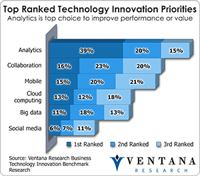The necessity of learning is essential for every organization to realize the full potential of the workforce. But many organizations treat learning like training or academic instruction to ensure policy or compliance to a minimum level of work performance, instead of continuing career education and improving skills in the operational workflow. The context for where and how workers work is critical to ensure that on-the-job learning is possible. While traditional learning management systems...
Read More
Topics:
Human Capital Management,
Learning,
LMS,
Digital Business,
inkling,
LXP
Partners play a key role in the revenue and growth of every organization. Whether channel selling is in assistance to internal sales or independent, what happens in partnering has ramifications that are simply too important to underestimate. The imperative to maintain business continuity with channel partners becomes painfully clear in a global pandemic, and that imperative demands that organizations cultivate partner excellence and channel performance. This effort should start with partner...
Read More
Topics:
Big Data,
Customer Experience,
Learning,
Office of Finance,
Voice of the Customer,
Business Continuity,
Analytics,
Digital Technology,
Work and Resource Management,
Operations & Supply Chain,
Sales Enablement and Execution,
Conversational Computing,
work experience management,
partner management,
AI & Machine Learning
The workforce is the center of any organization, no matter if the workforce consists of employees, contractors or what we call gig workers. It stands to reason that a black-swan event has an immediate impact on a workforce and thus an organization’s overall business health. In challenging times, a “family-first” mentality tends to take hold — a reality that, far too often, business leaders and HR organizations underestimate. But organizational readiness is essential for sustainability and...
Read More
Topics:
Big Data,
Customer Experience,
Learning,
Voice of the Customer,
Business Continuity,
Analytics,
Digital Technology,
Operations & Supply Chain,
Sales Enablement and Execution,
Conversational Computing,
AI & Machine Learning
Maximizing the performance and value of people in the workforce should be a primary focus for any business these days. It is a complex task, especially for larger organizations, and chances for success can be increased by investment in human capital management (HCM) applications. In this competitive software market SAP is making a strong push, aided by acquisitions in the last three years of SuccessFactors for talent management and more recently Fieldglass for contingent labor management....
Read More
Topics:
SAP,
Social Media,
HCM,
Human Capital Management,
Learning,
Operational Performance Management (OPM),
Performance,
Recruiting,
SuccessFactors,
Analytics,
Business Analytics,
Cloud Computing,
Business Performance Management (BPM),
Compensation,
Financial Performance Management (FPM),
HRMS,
Vendor Management Systems,
Workforce Analytics,
Workforce Management,
Workforce Planning
Read More
Topics:
Social Media,
Human Capital Management,
Kenexa,
Learning,
Performance,
Recruiting,
Smarter Analytics,
Smarter Workforce,
Social Business,
Social Collaboration,
Business Analytics,
Business Collaboration,
Business Mobility,
Cloud Computing,
Governance, Risk & Compliance (GRC),
IBM,
Compensation,
Financial Performance Management (FPM),
Workforce Performance Management (WPM)
Acquisitions and new product releases continue to make the market for human capital management a hotbed of activity, as organizations attempt to fully utilize and increase the value of their workforces as I have outlined in my research agenda. ADP, with more than $10 billion in revenues and more than 570,000 customers, is aiming for the top spot in this market.
Read More
Topics:
Mobile,
Social Media,
HCM,
Human Capital Management,
Learning,
LMS,
Operational Performance Management (OPM),
Performance,
Business Analytics,
Business Mobility,
Cloud Computing,
Business Performance Management (BPM),
Compensation,
Financial Performance Management (FPM),
HR,
Sales Performance Management (SPM),
TCM,
Workforce Performance Management (WPM)
Investing wisely in sales-related people and processes is a key to business success. In 2012, helping sales staff perform at their highest levels should be a top priority for management. That may take some effort, according to our benchmark research, which indicates that only 14 percent of sales organizations operate at the highest level of innovation and competitiveness. In recent years, most organizations merely discussed moving beyond using only their sales force automation application and...
Read More
Topics:
Big Data,
Mobile,
Planning,
Sales,
Social Media,
assets,
Learning,
Office of Finance,
Operational Performance Management (OPM),
Performance,
Reporting,
Sales Compensation,
Sales Force Automation,
Analytics,
Business Analytics,
Business Collaboration,
Business Mobility,
Cloud Computing,
Collaboration,
Business Performance Management (BPM),
channel,
coaching,
commission,
CRM,
Customer Performance Management (CPM),
Financial Performance Management (FPM),
Sales Performance Management,
Sales Performance Management (SPM),
SFA,
Workforce Performance Management (WPM)
The state of the economy has intensified scrutiny of organizations’ people assets, and so we’re seeing new dialogues about human capital management. Deriving full value from the people in a workforce requires more than just HR managing annual performance reviews or occasional scrutiny of the compensation processes for increases to merit pay or incremental incentives. Investing wisely in workforce-related processes requires assessment and optimization using analytics that can provide a lens on...
Read More
Topics:
Learning,
Operational Performance Management (OPM),
Performance,
Business Analytics,
Business Mobility,
Cloud Computing,
Mobility,
Business Performance Management (BPM),
Compensation,
Sales Performance Management (SPM),
Talent Management,
Workforce Analytics,
Workforce Performance Management (WPM)
Recently Human Concepts sold its personal organizational structure software OrgPlus to Administaff . Since it retains other products with the OrgPlus name, this step might seem puzzling, but it makes sense in terms of the company’s developing product strategy. The sale also frees Human Concepts to focus on organizations with more than 1,000 employees, where growth is more readily available. Human Concepts is experienced in the workforce management market; its customer and partner Zentiva Group...
Read More
Topics:
Learning,
Operational Performance Management (OPM),
Performance,
Business Mobility,
Cloud Computing,
Business Performance Management (BPM),
Compensation,
Customer Performance Management (CPM),
Sales Performance Management (SPM),
Talent Management,
Workforce Analytics,
Workforce Performance Management (WPM)
The talent management software market has and continues to consolidate dramatically through acquisitions. The trend is to bring together processes and applications for hiring, onboarding, performance assessment, compensation, succession planning and analytics. As the race continues to attract customers and users by presenting the most integrated suite of applications, a new market segment has evolved in the shadows and is now taking the stage in talent management. Talent Technology, a vendor in...
Read More
Topics:
Human Capital Management,
Learning,
Operational Performance Management (OPM),
Performance,
Recruiting,
Cloud Computing,
Business Performance Management (BPM),
Compensation,
Hiring,
Talent Generation,
Talent Management,
Workforce Analytics,
Workforce Performance Management (WPM)
















